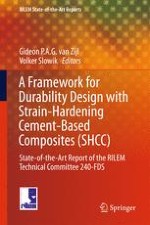This book captures the state of the art of the durability of fibre-reinforced strain-hardening cement-based composites (SHCC) and the durability of structures or structural elements manufactured in full or in part with this class of modern construction materials. Highlights include:
- Reflection on durability performance of existing applications in patch repair, a water reservoir and highway bridges.
- Guidelines for tensile testing towards durability assessment of cracked SHCC.
- New crack pattern related ingress rate indices for water and chloride into cracked SHCC.
- The influence of low and high temperatures on SHCC durability performance.
- The mechanism of crack control reducing ASR and corrosion rate, and results on chloride-induced corrosion of embedded steel reinforcement.
- Self-healing of cracks in SHCC.
- A conceptual durability design framework for SHCC and R/SHCC structures and members.
